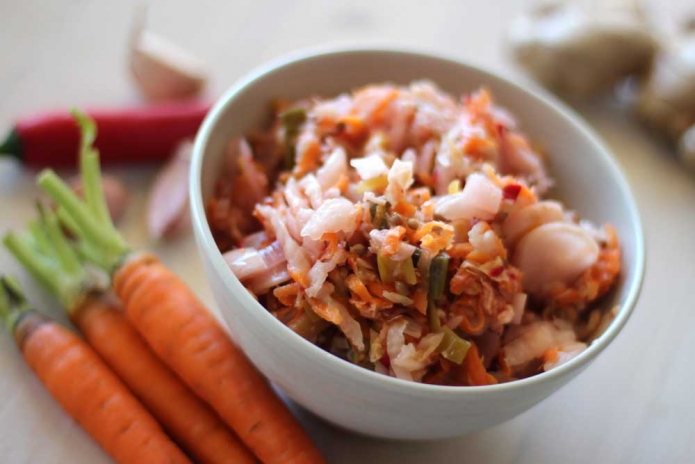Recipes
Kimchi

This cheeky exotic Korean delicacy is loaded with vitamins A, B, and C and healthy bacteria such as lactobacilli found in fermented foods. This good bacteria helps with digestion and assist in regenerating a healthy micro biome or gut bacteria balance, which is essential for physical and even mental health.
Makes approximately 1 litre of kimchi
Ingredients
500 g Chinese cabbage
5 Radishes
2 medium size carrots
1 Onion
3 cloves of garlic
1 large red chilli
3 tbs Ginger
2 tbs Coriander seeds
Filtered water
1 tbs Himalayan crystal salt
Special tools
A crock pot or a jar with a fermentation/air-lock lid that seals the jar and stops air coming in and lets the gas from fermentation out.
This recipe fits in a 1.5 litre jar
Method
Make the brine. Boil 200 ml filtered water and add 1 tablespoon Himalayan salt to dissolve. Add 800 ml cool water to make up in a total of 1 litre of lukewarm water. No warmer than body temperature.
Prepare the vegetables. Remove one cabbage leaf and keep for later. Chop the cabbage coarsely, slice the radishes and grate the carrot finely. Add to a bowl and cover with the brine. Weigh down the vegetables with a plate to keep the vegetables submerged. Cover and leave to soften for a few hours or overnight.
Prepare the spices. Grate the ginger, remove the seeds from the chillies and finely chop the garlic. Slice the onion. Add the coriander seeds. Mix together to made a coarse ‘paste’. Drain brine of vegetables, preserving the brine and set aside. Mix vegetables and ‘spice paste’.
Stuff the vegetables into a clean 1.5 litre jar or crock pot. Pack the vegetables thoroughly into the jar leaving about 4 cm of space at the top. Cover the vegetables with the cabbage leaf tucking the leaf around the edge, making a cover that stops the vegetables from floating to the top. Place a fermentation weight or ceramic stones on top to weigh the vegetables down. Poor brine into the jar. Submerge the vegetables and include a minimum 4 cm brine above the surface of the vegetables.
The vegetables must be covered by the brine or they can go moldy. Keep the remaining brine in the fridge in case you need to refill the jar during the fermentation process. Seal the jar and leave in a dark place at room temperature for 1 – 3 weeks. Check to make sure there is enough brine during the process. Top up with more brine if the vegetables are no longer submerged in the brine.
The speed of the fermentation process will depend on the room temperature. In the Queensland summer I leave mine for 1 week. You can taste the kimchi as you go along. When the kimchi has the desired taste, store in the fridge. Serve as a condiment alongside breakfast, lunch or dinner.
General fermentation tips
Always use clean, even sterilised utensils and jars for fermentation to avoid growth of unwanted bacteria. Use organic or spray/chemical free spices and vegetables. Always use clean, filtered water without chlorine and fluoride. Chemicals from treated water and vegetables my inhibit the natural fermentation process.
Enjoy!